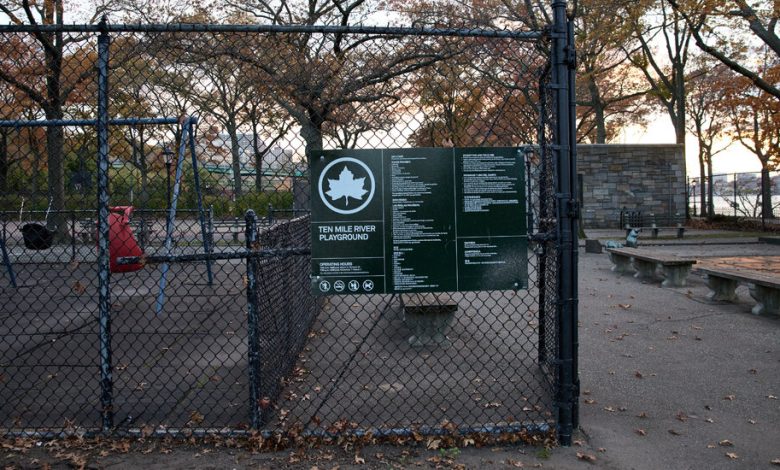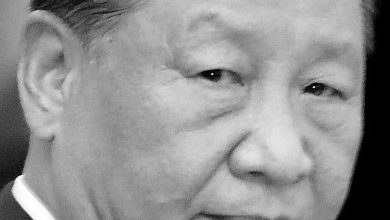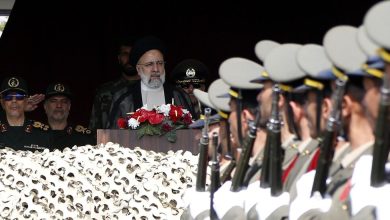Robert Moses Put Monkeys in a Park in Harlem. They’re Finally Gone.

At first glance, the metal trellis adorning a public bathroom in a playground in Riverside Park may have appeared innocuous. It was made up of four posts, each decorated with a long-tailed iron monkey.
But there were troubling details. The monkeys were black. They were connected to the trellis by their wrists, which were shackled. And the park, known as the Ten Mile River Playground, was located in Harlem, a predominantly Black neighborhood — a fact that seemed to many to be beyond coincidence.
Shiloh Frederick, a content creator who focuses on New York City history, first learned of the monkeys while reading “The Power Broker,” Robert A. Caro’s seminal 1974 biography of Robert Moses, the parks commissioner who transformed the city through public works projects. Mr. Moses oversaw an expansion of Riverside Park in the 1930s.
Mr. Caro wrote that Mr. Moses was known for adding details that made his projects “fit in with their setting,” generally with an eye to making people feel “at home.”
The trellises on the public bathrooms in other sections of Riverside Park featured more neutral decorations, like “curling waves,” Mr. Caro wrote. But the Harlem playground, he noted, featured monkeys.
Ms. Frederick, 28, set out to see the trellis in question for herself in September, filming her expedition for her followers on Instagram and TikTok. She told them she was looking for something she hoped she wouldn’t find.
It had been almost 50 years since “The Power Broker” was published, after all. Ms. Frederick assumed the monkeys had come down long ago.
“Lo and behold,” she said in an interview, “they were still there.”
While widely considered a visionary, Mr. Moses was also racist — “unashamed, unapologetic,” Mr. Caro said in a reflection on writing “The Power Broker.” How much racism influenced Mr. Moses’s projects is a source of some debate.
He bulldozed Manhattan’s vibrant San Juan Hill neighborhood, home to a large Black and Latino population, to make space for Lincoln Center. He built the Cross Bronx Expressway, a highway that cut through multiple neighborhoods in the South Bronx and displaced thousands of people. And he built bridges with clearances too low for public buses, effectively banning low-income people from accessing some of his parks.
In the reflection, Mr. Caro noted that Mr. Moses kept water temperatures “deliberately frigid” in pools he didn’t want Black people to use. Mr. Caro declined to comment for this article.
Ms. Frederick grew up in Brooklyn and knows how long change can take in the city. So when she found the monkeys in the playground, she was shocked, but not necessarily surprised.
But the reaction to her video, which quickly garnered nearly 45,000 views on TikTok, far exceeded her expectations.
She began posting New York-centric videos on social media last year and said that she enjoyed sharing the city’s history in a lively way.
“It’s not just, you know, dead guys and words on the page,” she said.
But she had feared people would respond to her video about the monkeys by saying that Mr. Moses was simply a man of his time and that nothing needed to be done.
“Just because something is old, it doesn’t deserve to be on display in perpetuity, especially if the intention behind it was negative,” she said. “Our cities aren’t just stuck in amber. We’re not just working with what we have. These are living, breathing organisms, right? And they have to be modified to reflect our needs and values.”
Ms. Frederick returned to the playground more than a month later, braving a rainy day to confirm what some of her followers had told her: that the monkeys had finally been taken down.
Her triumphant video confirming the news, as previously reported by the Daily Dot and the Columbia Spectator, received more than twice as many views as her first one.
Kelsey Jean-Baptiste, a spokeswoman for the Parks Department, said in a statement that conversations regarding the “intention and symbolism” of the monkeys had been “ongoing long before” the video.
“NYC Parks strives to ensure our public spaces are welcoming to all New Yorkers to reflect the inclusivity and diversity of our great city,” the statement said.
Shaun Abreu, the City Council member whose district includes the playground, said that he and the Council speaker had been preparing to announce a $7.4 million renovation of the playground and the monkeys came up during the planning process.
“There’s not really enough evidence that this was something special for us to protect,” Mr. Abreu said. “So we decided to have them removed.”
Ms. Frederick said she had never intended to become an activist and that she would continue to keep people informed about the city.
As a history buff and New York native, she also said she had complicated feelings about Mr. Moses.
“I don’t necessarily think Robert Moses is a villain or a hero,” Ms. Frederick said. “I would say that the monkeys were one of the more negative contributions that he made, but he also did do a lot of good things for the city.”



